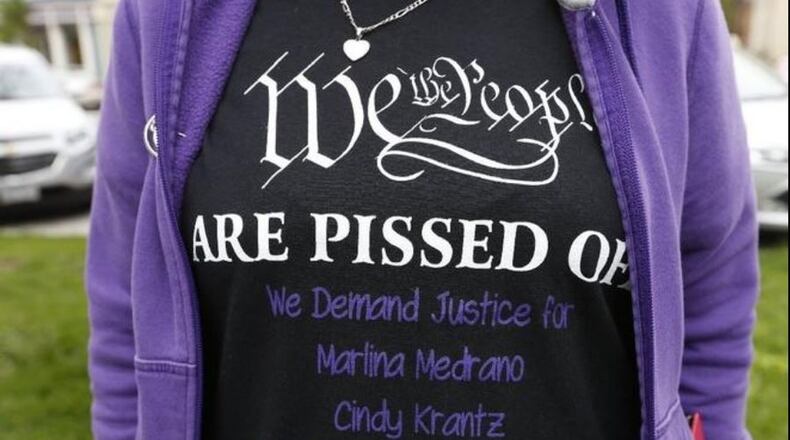Current law defines domestic violence as occurring between spouses, ex-spouses, family members, those living together or parents. It leaves out boyfriends and girlfriends in intimate or dating relationships where the same patterns of domestic abuse and violence often play out.
“It’s happening all the time. It’s just so dangerous. Any way we can intervene and use the power and the strength and the authority of the law to help these women get out of these relationships, we have to do it,” Sykes said. “The sooner, the better because it’ll be easier for them to break those ties and keep them from ending up in a very deadly situation.”
Examples of domestic violence turning deadly are common across Ohio: two Westerville officers were killed in February when responding to a domestic dispute; four people, including the shooter and the Kirkersville police chief, were killed in May 2017 in another domestic dispute; and in August 2017, a woman was sentenced to 25 years in prison for murdering her ex-husband after he sought full custody of their children.
Related: Protection orders work but didn't help victim in Kirkersville shooting House Bill 1 will allow victims of dating violence to obtain civil protection orders through domestic relations courts.
Sykes acknowledges that a piece of paper from a court isn’t 100 percent effective, but she said studies show the orders are followed 75 percent of the time, making them helpful tools in ending cycles of abuse.
When abuse starts
Dating violence can be physical, sexual or emotional: hitting, shoving, choking; unwanted touching or pressure to have sex; being extremely controlling, threatening to harm self or others, stalking or using put downs and insults.
Sykes, who holds a law degree and a master’s in public health, said the earlier a woman can break free from abusive relationships, the better.
Often, abuse starts early. In the 2015 National Youth Risk Behavior Survey, almost 12 percent of high school girls reported physical violence and nearly 16 percent reported sexual violence from a dating partner in the previous 12 months.
Forty-three percent of college women report experiencing violent and abusive dating behaviors.
The Centers for Disease Control and Prevention reports that one in four women and one in nine men were the victims of intimate partner violence, leading to fear, safety concerns and symptoms of PTSD.
Related: Should children be allowed to get married? In Ohio, thousands do
Lengthy effort
The effort to extend civil protection orders to victims of dating violence began in 2008 when then state representative Edna Brown, D-Toledo, introduced a bill. The dating violence portion was stripped out of Brown’s bill.
Sykes, the daughter of two Ohio lawmakers, finished law and graduate school, returned to Akron and volunteered at a community legal services agency where she discovered that Ohio lacked protections for victims of dating violence.
When she joined the Ohio House in 2015, she teamed up with Cincinnati Democrat Christie Kuhns to pick up where Brown left off. They conducted a 50-state survey and developed a spreadsheet” with 48 ways to define dating violence, Sykes said.
The 2015 bill passed the House but died in the Senate.
Then Sykes and state Rep. Nathan Manning, R-North Ridgeville, introduced House Bill 1 on Feb. 1, 2017, passing it 28 days later. The Senate passed it this year.
The only public opposition came from the Ohio Public Defender’s office, which said the definition of dating violence was overly broad and offering protection orders to ex-boyfriends and ex-girlfriends could turn into he said/she said disputes.
“To be perfectly frank, this bill requires judicial officers to sort out the complicated emotional and sexual interactions of two people to determine if those exchanges were romantic or intimate,” said testimony from the public defender’s office.
Related: Sexting and teens: Ohio looks to set up diversion program as problem grows
Types of protection orders in Ohio
Civil protection order: It’s a legal document that restrains one party from contacting another party, such as those involved in domestic disputes. Issued by a court after a hearing, it can last up to five years.
Temporary criminal protection order: Issued by a court while a criminal case is in progress. It expires once the case is closed.
Anti-stalking civil protection order: This is an order issued by common pleas or juvenile court against someone convicted of stalking or sexually oriented offenses against an individual. The order can last up to five years.
Juvenile civil protection order: Issued by juvenile court, it is an order that applies only when the parties are minors.
What is dating violence?
Behaviors that include physical, sexual and emotional abuse between individuals in a romantic or intimate relationship. Physical abuse may include hitting, choking, shoving, grabbing, pulling hair. Sexual abuse may include pressuring someone to have sex or forcing them to have unsafe sex, unwanted touching, ignoring pleas to stop sexual advances. Emotional abuses may include being extremely possessive or controlling, stalking or harassing, threatening harm to self or others, using put downs and insults and misusing someone’s social network.
About the Author

